|
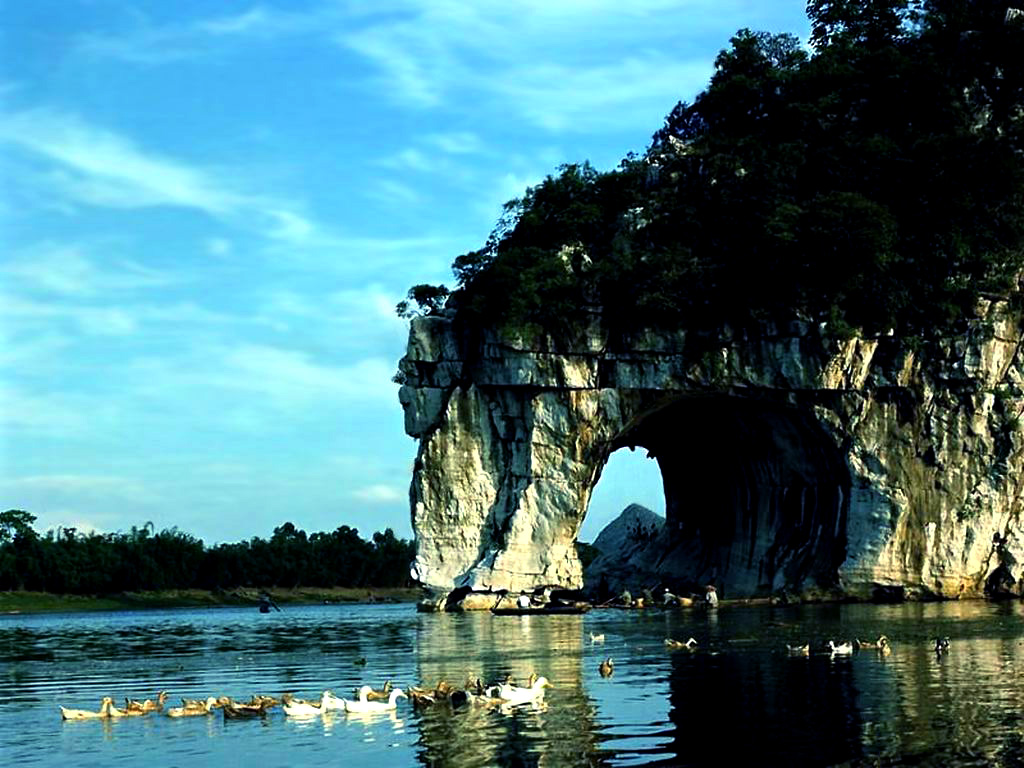 Overview Overview
Guilin is in the northeastern corner of the Guangxi Zhuang Autonomous Region. It just sits on the west bank of the Li River, covering an area of 2,000 square km, with a population of 1.2 million. Major nationalities living in the cities include Han, Zhuang, Miao, Yao and Dong.
Guilin has a history of more than 2,000 years. It is famous in the world for its green hills, clear water, fantastic caves and spectacular rocks. It has typical karst topography. Scientists believe that Guilin was an ocean between 370-325 million years ago. Between 200-180 million years ago, because of changes in 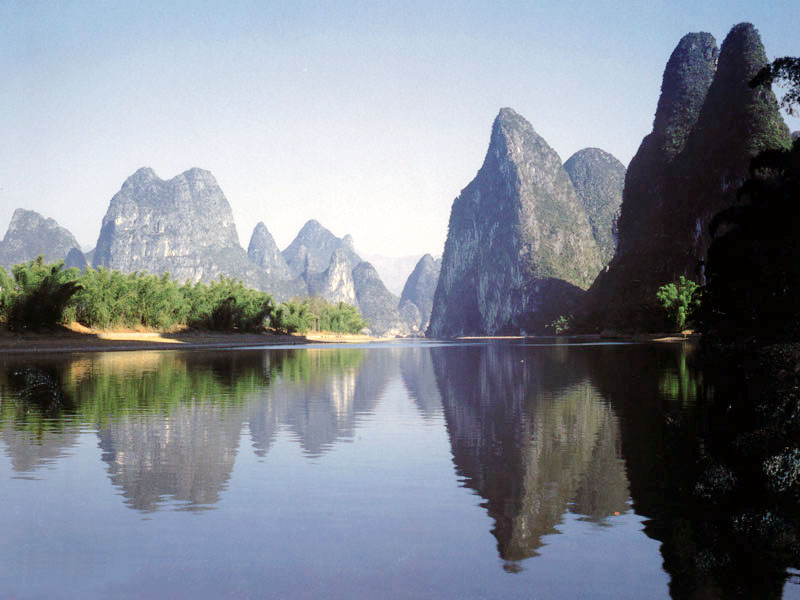 the earth's crust, the bottom of the ocean rose up and became land. Over subsequent centuries, the erosion effect gave rise to a myriad of eerie-looking peaks, underground rivers and caves. the earth's crust, the bottom of the ocean rose up and became land. Over subsequent centuries, the erosion effect gave rise to a myriad of eerie-looking peaks, underground rivers and caves.
The hills and pinnacles in Guilin, gifted by nature, rise sharply from the ground in many different shapes. Diecai Hill, Fubo Hill, Duxiu Peak, Nanxi Hill, Crescent Hill and Putuo Hill are the biggest attraction for tourists when they make a tour of the city.
The Li River is in the region of Guilin. Elephant Hill, Chuanshan Hill, Pagoda Hill, Qifengzhen Peak Forest, Crown 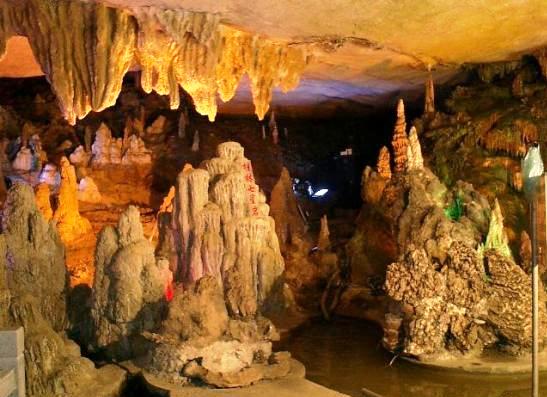 Cave, Painted Cliff, Xingping Town and Green Lotus Peak are the extraordinary scenic spots along the river. Cave, Painted Cliff, Xingping Town and Green Lotus Peak are the extraordinary scenic spots along the river.
Grotesque caves can be found in all the Guilin hills. Reed Flute cave, Seven-Star Cave and Chuanshan Hill are honored as 'Palaces of Nature's Art'. Stalagmites in the caves present colorful pictures.
Linking the waters of the Xiang and Li Rivers, the Ling Canal in Xingan County, north of Guilin, is a great ancient water conservancy project in Chinese history. It was built over 2000 years ago during the reign of the First Emperor of the Qin Dynasty.
Attraction
One of the top China's tourist destinations, Li Rievr is honored to the most beautiful gallery of the world. The picturesque river is a major component of Guilin scenery. As it sparkles in the sunlight the river meanders through lush mountains like a liquid jade belt. To really appreciate the scenery a cruise from Guilin to Yangshuo is a must and your voyage of discovery can be divided roughly into three sections:
The first of these is from downtown Guilin where you board the cruiser to Huangniu Xia (valley). As soon as you leave the landing stage you will begin to enjoy the natural wonder and local customs. Upon reaching Huangniu Xia (valley) the cruise enters upon the second section. This part is the very essence of Li River. The gorgeous mountains and the crystal water together with the romantic legends are certain to impress you. Shuiluo Village marks the beginning of the third and final section that ends at Yangshuo. Along this stretch of the river you pass through pastoral scenes unchanged for generations as the banks are lined with quaint fishing villages, farmland and bamboo groves.
Located at the confluence of the Taohua (Peach Blossom) River and the Li River, Elephant Trunk Hill is too famous to be missed. It is said to be the symbol of Guilin scenery and also a highlight in Li River.
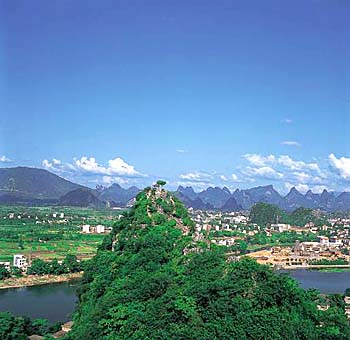 Diecai Hill, also named Gui Hill, famous for its amazing scenery and stone caving, is one of the most attractive scenery in Guilin. The easiness for climbing makes great contribution to its popularity among visitors. Diecai Hill, also named Gui Hill, famous for its amazing scenery and stone caving, is one of the most attractive scenery in Guilin. The easiness for climbing makes great contribution to its popularity among visitors.
Seven-Star Park is located on the bank of Li River, crossed by Xiaodong River. The park got its name owing to seven peaks looking like Charles' Wain. This is the largest and most popular park in Guilin with the longest history. Hills, rivers, caves and stones are highlights of this park.
Reed Flute Cave is 5 kilometers (3miles) from downtown in northwest suburb of Guilin. Here the scenery is focused on caves, and their rural setting. Within the cave there are enchanting stalagmites, stone pillars, stele, stone curtains and stone flowers.
Dining
Guilin enjoys its fame for its exotic dishes and the sights of dogs, birds, turtles, snakes and other weird animals in their cages at restaurant. Don't be afraid though, if you are not feeling extremely intrepid, there are plenty of tasty options for those who prefer their regular food.
Guilin cuisine is a combination of Hunan and Cantonese cuisines, which means it serves not only dishes with spice and chili, but also emphasize on freshness and use of selected sauce.
Often characterized by its sweetness and a touch of spice, the flavor of Guilin is indeed unique. Traditional ingredients of Guilin recipes include (somewhat to the horror of animal lovers) dog, bamboo rat and turtle meats! However, the vast variety of local dishes here make it possible for one to sample the distinct flavor of Guilin without having to come into contact with those meats. 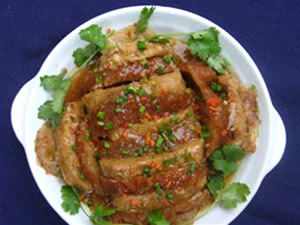
Lipu Taro looped Meat: This famous dish is made of taro from Lipu (104km south of Guilin) combined with streaky pork with skin, pepper, mashed onion, preserved bean-curd of Guilin, cooking wine, sugar etc. The final product is golden and aromatic with taro's scent.
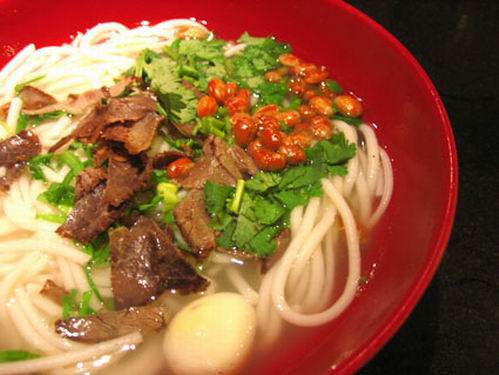 The Guilin Rice Noodle: The Guilin rice noodle is the most popular local snack and the residents' favorite. The rice noodle is prepared with gravy, fried peanuts or soybeans, chopped scallions and slices of beef. The Guilin Rice Noodle: The Guilin rice noodle is the most popular local snack and the residents' favorite. The rice noodle is prepared with gravy, fried peanuts or soybeans, chopped scallions and slices of beef.
Pickled Vegetable: The Chinese pickles are made of selected vegetable soaked in vinegar and sugar and preserved for a couple of weeks. It tastes sour and sweet and is used to serve with meat dishes. Local people believe the dish can arouse the appetite and help digestion.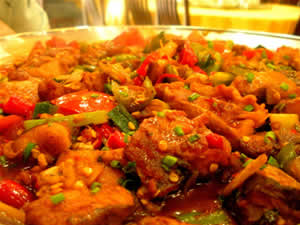
Beer fish: the dish was first created in Yangshuo ( 64 km south of Guilin). Mixed with other ingredients, fish is stewed with beer, which forms very delicious gravy in the pot. It has become the No.1 dish in Yangshuo. Every year there is a beer fish contest in town for the best taste prepared by the chefs.
Oil-tea: Originated in the areas of ethnic group like Dong and Yao, oil tea was first created to ward off the moisture entering people's body and keep warm. People there boil the tea with ginger, scallion and serve with fried rice, peanut. Now the habit has been widely spread in North Guangxi, and the most famous one is Gong Cheng oil-tea.
Shopping
Local Specialties:
Guilin sanhua alcohol, Guilin fermented bean curd and Guilin chili sauce are considered to be Guilin's three treasures, and are top choices with visitors to the city.
Products made from sweet-scented osmanthus are also recommended since the name of Guilin literally means forests of osmanthus. Osamnthus tea, sugar and wine will bring you sweet memories of this city.
The gingko tree is described as a living fossil. Gingko is said to promote healthy blood circulation, moistens facial skin and so chases away wrinkles. It is so versatile that it can also be made into drinks and snacks.
Guilin chufas can be eaten as fruit or as a vegetable. Chufas, sometimes referred to as tiger nuts in the West, are grown in Guilin and are very sweet and crispy. Chufa paste, chufa panocha and canned chufa each have their own unique flavors and will add extra zest to your cooking.
Luo Han Kuo got its name as it looks like the belly of Buddha. Luohan means arhat in Chinese. This fruit has long been a traditional Chinese herb. It is sweet and mellow and is considered conducive to the system and helps lower blood pressure. Instant Luo Han Kuo tea is a very convenient way to prepare it and preserves the original flavor of the fruit.
|